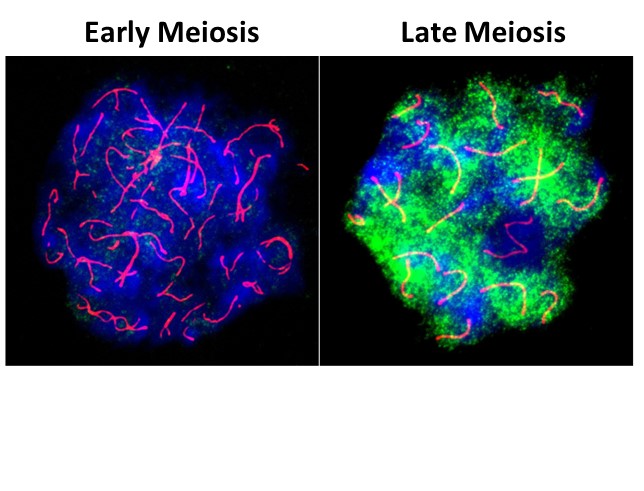There are two types of cell division: mitosis and meiosis. Only germ cells, the precursors of gametes, are able to undergo both divisions. All other cells of the body can divide only by mitosis. Spermatogenesis, which leads to the production of male gametes (spermatozoa), therefore involves both types of division. During the first phase of this highly complex process, spermatogonia—germline stem cells—divide by mitosis and progressively differentiate into spermatocytes. In the following phase, meiosis of spermatocytes produces haploid spermatids, which then develop into mature spermatozoa.
A key transition: from mitosis to meiosis
A critical step in spermatogenesis is the transition from spermatogonia to spermatocytes. This transition is orchestrated by the STRA8 factor, which initiates the process. At the onset of meiosis, DNA undergoes breaks that are repaired by homologous recombination. These key meiotic events ensure genetic shuffling between paternal and maternal chromosomes. At this stage, the sex chromosomes (X and Y) cannot pair and instead cluster together in a structure where they are inactivated—a mechanism known as MSCI, for Meiotic Sex Chromosome Inactivation.
Reduced transcriptional activity
The researchers observed a widespread reduction in gene activity when cells enter meiosis, a phenomenon called early meiotic low transcription (EMLT), which also appears to be regulated by Stra8. Unlike MSCI, EMLT affects the entire genome. Surprisingly, it occurs before the formation/repair of DNA breaks at the onset of meiosis and is not influenced by these events. This challenges the idea that DNA breaks govern transcriptional activity at the beginning of meiosis.
Tight control of meiosis
The researchers showed that, in parallel with reduced transcription, mRNAs are stabilized so they can be used at the right moment. The combination of reduced transcriptional activity and stabilization of messenger RNAs appears to play a key role in synchronizing the expression of genes involved in the first phase of meiosis, thereby ensuring the proper progression of spermatogenesis.
Thus, sperm production results from a finely regulated sequence of steps. Exploring these still poorly understood mechanisms could improve our understanding of certain forms of male infertility and pave the way for new therapeutic strategies.
 Contact : gabriel.livera@cea.fr
Contact : gabriel.livera@cea.fr